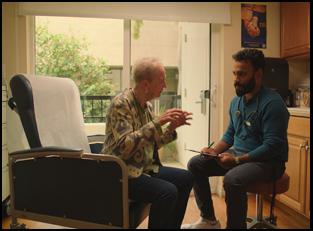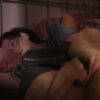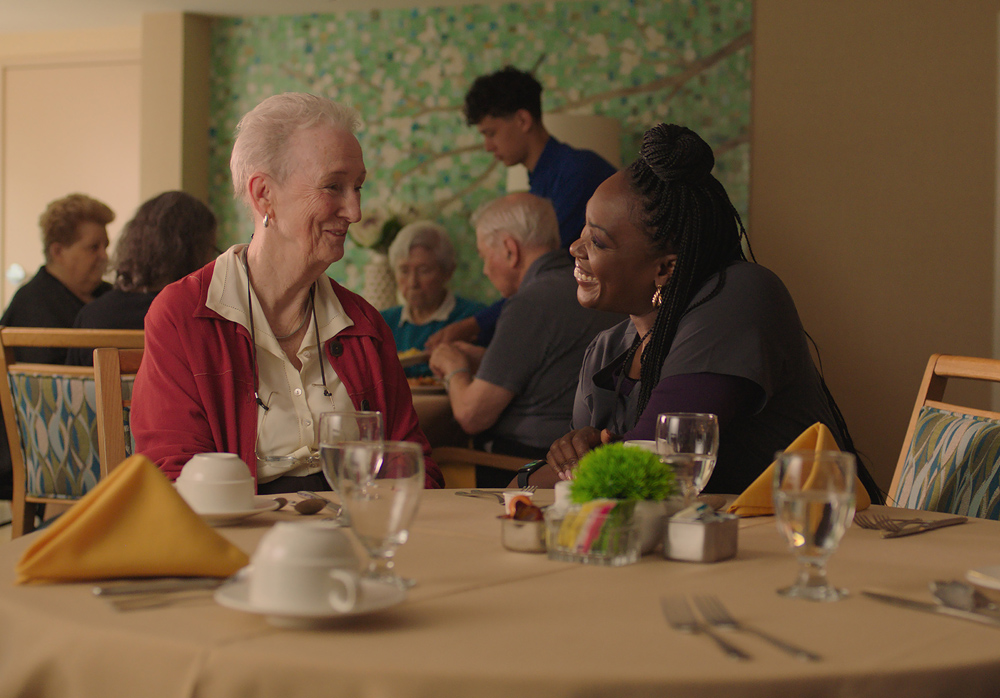A glitzy premiere at the Grauman’s Chinese may not always have the same magic as they once did when they can be counted on at least once a week, but during AFI Fest last fall, it would’ve been hard not to notice a particularly radiant crowd gathering on the red carpet for the bow of “Familiar Touch.” Facing a higher bar to clear when taking place at the adjacent multiplex in the Hollywood and Highland Mall, there was a real buzz in the air as a particularly well-dressed collection of passengers began to step out of buses from the Villa Gardens retirement community just a few miles away in Pasadena, making their presence known as movie stars before anyone could actually see them on the big screen inside and it felt as if you could get a glimpse of the filmmaker Sarah Friedland’s directing skills and her background in choreography as she hustled around the lobby making sure everyone was where they needed to be as they did a step-and-repeat for photographers on their way into the theater.
“It was the screening we had been waiting for,” Friedland says now about the film’s U.S. premiere after its debut at Venice. “Because we made this film in collaboration with this community of residents and care workers, and I wanted them to feel like we got it right and it was truthful to not only to their community, but to their experiences of aging, and their experiences of care work, and seeing everybody, all dressed up, walking the carpet, and then hearing everyone’s responses to the film was so moving.”
She adds, “I was coming from a few festivals in Europe, and my flight was canceled, so I made it in time within five minutes of it starting.”
You wouldn’t have known when Friedland didn’t break a sweat, patiently guiding the cast of her film around what must’ve been a nervous moment for herself as well, and that confidence comes through in her exquisite drama centering on Ruth (Kathleen Chalfant), a former chef whose knife skills remain intact despite her advanced age but her memory isn’t as sharp as it once was, leading her son (H. Jon Benjamin) to enroll her in a hospice facility. Friedland had initially been inspired to start work on a script a decade earlier by the experience of watching her own grandmother deal with the slow creep of dementia, very much physically active as she showed signs that the fierce intellect that she had long been defined by as a poetry editor began to diminish, as well as her own work helping to take care of elderly creatives where she would notice that they treated her as a contemporary rather than someone much younger, seeing how much they lived in the present.
It’s an observation that would ultimately become more powerful when paired with all the work Friedland had done in the time that followed, developing filmmaking workshops that could engage seniors creatively and making her own films – a trilogy of shorts called “Movement Exercises” – that might not have had an obvious effect on what became “Familiar Touch” yet in examining how people collectively make meaning with dance as a vivid expression for anxious moments in a number of social environments utilizing nonprofessional actors, it now seems like preparation for telling a story about Ruth finding her way into a new community as if she were entering high school all over again. (Not to mention the practical demands of surrounding the legendary stage actress Chalfant with the real-life residents of Villa Gardens and managing a crew in a facility that wasn’t exactly intended as a soundstage.)
The result is delicate at the same time it is pulsing with passion when it shows that Ruth’s lust for life hasn’t diminished in the least and as much as she must acclimate to her new surroundings, there’s considerable beauty in how a space starts to open up for her as well. After Friedland picked up a best director prize in Venice as well as a Someone to Watch Award from Film Independent in addition to the film collecting plenty of other accolades for Chaflant’s luminous central performance, “Familiar Touch” is now making its way to theaters and the filmmaker generously took the time to talk about the process that led to such an enriching experience for all of its participants, navigating some unforgiving schedule constraints and her ongoing Creative Aging filmmaking workshops in parallel with the film’s theatrical run.

It was many years of trying to find the right care community. I knew that it had to be what we might describe as more of an upscale facility because in part, this is a story about class. I imagine Ruth grew up working class, Yiddish is her first language, and experienced professional success that led her to a different class identity later in her life, so I was interested in what it would be like for her son, registering her for this privileged care facility and looking around and [she would] almost be like, who are these rich people? Not identifying with them as if she was a younger version of herself. That was one element of it.
The other element was knowing that we needed a place that had a specific culture around lifelong learning. I knew from the beginning that this had to be made collaboratively with a real care community, but wanted to find somewhere where there was actually interest in doing this, where it wasn’t us marching in and saying we’re making a movie, but where we were invited guests and where we could actually contribute something. Villa Gardens is a very specific community and a really special one in that it was founded by women educators almost a hundred years ago and it carries on that legacy in that a lot of retired educators live there, so there’s very much the spirit of lifelong learning. Discovering that was really key and that they were a community that was interested in having this kind of weird pedagogical experiment, if you will, of teaching a filmmaking workshop that then integrates with the script and feature film that is also a collaboration. It takes a very specific type of community that wants to do that. Their leadership, both Shaun Rushforth, their executive director, on the staff side and Jean Owen, the president of the residence council on the resident side, were wonderfully supportive. It’s almost a square peg, round hole [of] how does a film production integrate with the retirement community, and we found a way for that to come together. But it took a long time to search.
The other component was I knew I wanted it to be in California so that there would be a sense of not knowing how much time has passed — that Ruth might look out her window and not know if she’d been there for a month or two days because there’s no real seasonal change.

Yeah, there were a few threads that came together simultaneously. I’d been working as a caregiver part time, as my day job and really enjoying intergenerational relationships. Then at the same time I made a short film called “Home Exercises,” about the choreography of older adults in their homes. When I was filming it, I noticed that the performers I was working with were just as interested in the technical crew side of filmmaking as they were the performing side that they were doing. That led me to think that filmmaking has been really neglected as a subject of lifelong learning, so I started teaching filmmaking to older adults as an educator and in my day job. But those experiences were happening at the same time that I was revising “Familiar Touch,” so there wasn’t like one “light bulb” moment. It was more like the writing of the script and doing this work with older adults was happening at the same time and it became clear that both were informing the other, so by the time I started thinking about how to make the film, it was just clear to me that these different modes would be braided togethe and that would yield not only a more ethical and interesting production, but a truer film.
It was quite moving to learn that Carolyn Michelle, who plays the primary caregiver in the film, actually is the daughter of Carol Smith, who was one of the featured players in “Home Exercises.” What was it like to bring her into the mix?
Carolyn, by the way, is just an extraordinary actor. I think she gives such a beautiful performance and she also participated in the workshops. She taught the acting workshop at Villa Gardens because each week we had a different subject of filmmaking. I met Carolyn back in 2014 when I was Steve McQueen’s assistant and he was developing an HBO pilot. She was cast in that pilot and we became dear friends after that production. So when I had posted on Facebook, like I’m making this movie [“Home Exercises”] about older adults moving into their homes, she said, “Oh, you have to meet my mom!” So it’s funny that I got to film with her mother before I got to film with her because I remember watching her rehearse with Steve in 2014 and thinking, “Oh my God, like I have to make something with her one day. She’s so, so good.” And I did.
She’s incredible in it, as is Kathleen Chalfant, but it surprised me to learn her casting wasn’t locked in until right before filming when it seems like she must’ve had to prepare for this role for some time. What was it like to bring her on?
Everything came together very quickly at the end for a number of different complicated reasons and we didn’t have any time to spare because we were up against the strike. The strike ended up pushing [the production up] four days, and we planned to wrap at 11:59 before the strike started at midnight and we did. Then because the strike had pushed, we had our martini shot go to 12:01 just because we could to feel a little luxury in time. But Kathleen and I met very close to the start of filming. It had been many, many years of trying to find the right Ruth and it was clear from the moment we met that it had to be her.
[Kathleen] walked on the set and from the first shot, it was just clear that we got it right. I remember looking over at my [director of photography] and his eyes were welling up because we had just been talking about this film and this role for so long and it was just this overwhelming feeling of, “Oh my God, we found her.”And this character that I had been writing for so long that had really dried up on the page.That’s the danger of something taking so long. On the one hand, you can be meticulous and planning and prepping in that time, but on the other hand, a certain sense of spontaneity and a kind of spirit in the writing can dry up and being able to hand her the script, just trust her completely, and then see her bring the character to life beyond my imagination was just one of the most incredible things I’ve ever witnessed. Collaborating with her has changed my life.
Yeah, I think the benefit of being trained as a care worker and as a creative aging educator, and being trained in memory care, all of those jobs gave me the skill sets needed to figure out how to pull this off. Then simultaneously, my shorts are all experimental and made on a much, much smaller scale, so the one experience I hadn’t really had was of running a crew of this size, but I had worked on a lot of other filmmakers’ sets and those past experiences gave me the skills I needed to integrate all of these modes of working. It felt like a circus act that we somehow managed to pull off.
All this time you had the idea for this film in your mind, you were working on the shorts where you were really pushing the envelope formally. Did it actually expand your horizons as far as what you ultimately wanted the feature to be?
Yeah, the shorts taught me a lot about how to direct professional and non-professional performers together, either in the same scene or in the same film. I learned a lot from making “Drills” in particular, working with the high school students, and a lot about what is needed to [create] a communal feel [on set], making it comfortable for people who haven’t necessarily filmed anything before. I also learned a lot from all three of those films about economy. When you’re working in spaces that don’t have the control of a set that’s just yours, you have to be prepared to adapt an idea or a scene. All of a sudden, you don’t have this space, but you have the room next door and you have to figure out how this scene works there. Or you discover that someone needs to leave earlier because of health needs, so how do you get the scene that you thought was going to be three shots in two? That adaptability I learned from making the Movement Exercises trilogy.
The other thing that I learned was writing in movement sequences. In earlier drafts of the script, I tried to be a bit more plotted, a bit more dialogue-based, even though that’s outside of my comfort zone and a big part of this process was learning that my way of storytelling through movement could translate to a fiction feature and that actually the grammar, the style I had built in that trilogy could be adopted for this feature. There was a process of honing in on what was me in the script versus what was trying to be what I thought a narrative feature should be and eliminating all of that and coming more to the gestural style that I had been playing with in that trilogy over the last decade.
When you’ve been carrying this around for a while, what’s it been like to get it off your shoulders and out into the world?
Of course, it’s deeply gratifying that it’s resonating with people. That’s why you make films because I’ve had experiences in the cinema where I’ve walked into them and walked out with that feeling of having either my sensory or emotional or political experience of the world shift. That feeling of getting to leave the cinema with some part of you altered is at least why I make films. But the weird Catch-22 of filmmaking is you can’t know that yourself because when you watch a finished work, it doesn’t have that effect on you. You see the mechanisms of how you made it. You see the tears and seams in how it’s constructed, so knowing that it’s meaningful to people is incredibly gratifying and seeing that it’s had an impact on people in other countries — that it’s not just resonating with Americans — has been really beautiful. There’s also a relief in not having to carry it anymore. I think when you hold on to an idea that long, your grip gets so tight and it becomes hard to have space to think about other ideas, so for me, there’s a beauty in getting to turn it over to an audience and say it’s yours now and then I get all of this mental real estate back to start chewing on other ideas.

It’s been wonderful. We’ve done four workshops on the festival circuit and we have three coming up during the first week of the U.S. release and hoping to do more throughout the rest of the film’s life. It just felt like the workshop process was so generative and meaningful on both ends, not only for the older adults who did the workshop, but for us who facilitated it, that it shouldn’t just end with production. That should continue into the circulation and next step of the film’s life. We’re doing one at the SAGE Center here in New York in a few weeks and then another in L.A. and another one in Detroit and we’ve been doing these afternoon capsule workshops that have been introductions to film and it’s really satisfying to watch older adults and their care partners learn some of the tools and grammar of filmmaking and then go see the feature and be like, “Oh, yeah, I get how it’s made.” For me, it’s really exciting to watch older adults discover a new art form that they can express themselves in.
“Familiar Touch” opens on June 20th in New York at Film Forum and June 27th in Los Angeles at the Laemmle Royal, Glendale and Encino Town Center. A full list of theaters and dates is here.




